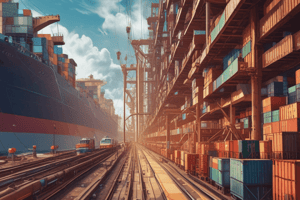Podcast
Questions and Answers
Which of the following statements is false?
Which of the following statements is false?
- Apples and bananas.
- Bananas, lemons and dates.
- Bananas, lemons and peas.
- Apples and lemons.
- None of the above. (correct)
Which of the following statements is false?
Which of the following statements is false?
- The Balassa index measures comparative advantages and can be linked to a classical trade theory.
- The Leontief paradox was a test of the Heckscher-Ohlin theory and concluded that the US imported capital-intensive goods.
- Technological differences and multiple countries are two relaxations of the HO model, which increased its explanatory power.
- Examining the lobbying and voting behavior of different sectors in relation to free trade and protectionism served to support the HOV model.
- None of the above. (correct)
According to the theory of comparative advantage, countries will gain from trade because:
According to the theory of comparative advantage, countries will gain from trade because:
- Trade makes companies more competitive and reduces their market power.
- All companies can benefit from cheaper labor.
- Output per worker in every company increases.
- World output will increase if each country specializes in what it is relatively best at. (correct)
- None of the above.
Which of the following statements is false?
Which of the following statements is false?
Which of the following statements is not a proposition of the theory of similar demand by Linder?
Which of the following statements is not a proposition of the theory of similar demand by Linder?
Flashcards are hidden until you start studying
Study Notes
Multiple Choice Questions
Comparative Advantage and Trade Theories
- The Balassa index measures comparative advantages and can be linked to a classical trade theory.
- The Leontief paradox was a test of the Heckscher-Ohlin theory and concluded that the US imported capital-intensive goods.
- Technological differences and multiple countries are two relaxations of the Heckscher-Ohlin (HO) model, which increased its explanatory power.
- Examining the lobbying and voting behavior of different sectors in relation to free trade and protectionism served to support the Heckscher-Ohlin-Vanek (HOV) model.
Gains from Trade
- Countries will gain from trade because world output will increase if each country specializes in what it is relatively best at.
- Specialization leads to increased output per worker in every company.
Temporary Comparative Advantage
- The question gap with R&D efforts leads to a temporary comparative advantage.
- The first phase in the production of a new, expensive product often takes place in capital-rich, high-wage countries.
- In the saturation phase of the product life cycle, production processes have been standardized.
Theory of Similar Demand
- Imports in a country are determined by GDP/capita, according to the theory of similar demand by Linder.
- Demand in a country is determined by GDP/capita.
- Exports to countries with similar GDP/capita as the country of origin are proposed by the theory.
Studying That Suits You
Use AI to generate personalized quizzes and flashcards to suit your learning preferences.




